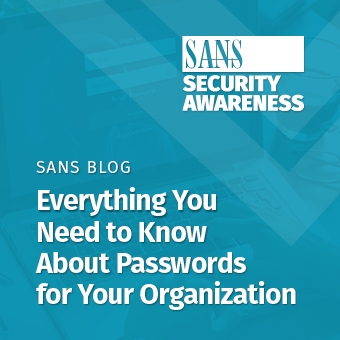Today, May 5, is World Password Day—the perfect opportunity to talk about one of my favorite topics, strong passwords. Weak passwords, or poor password use, has become a primary driver for breaches. Cyber attackers are actively targeting and leveraging compromised passwords not only to gain access to organizations, but to quietly pivot and traverse organizations so they can accomplish their goals undetected. As such, organizations are implementing solutions—both technical and training—to ensure staff are not only using strong passwords but are doing so in a secure manner. However, in today’s world secure passwords are no longer enough because they still represent a single point of failure. Even if you have the longest, most secure password in the world, if that password is compromised cyber attackers have full access to your account, system, and data.
One of the most effective and proven approaches for strong authentication is something called Multi-Factor Authentication, or MFA for short. MFA is when multiple factors of authentication are used before access is granted. This way, if your password is compromised, your account, system, and data are still safe as the other factor or factors still protect you. MFA is becoming a popular solution, but there can be a great deal of confusion about exactly how MFA works as well as the different implementations of it. As such, here’s a short explainer to better prepare you to train your workforce on this highly effective approach to strong authentication.
What is MFA?
MFA, an acronym for Multi-Factor Authentication, is considered one of the strongest methods of authentication. Microsoft estimates that MFA defeats 99% of authentication-based attacks. While not foolproof, MFA is one of the most effective steps organizations can take to dramatically reduce the risk of a breach. At its simplest level, MFA is multiple levels of authentication in which an individual authenticates not only with a password (something they know), but some type of unique code or device they have. Even if their password is compromised, their account and data are still safe because the cyber attacker does not have access to the second form of authentication. Unfortunately, that is where the simplicity of MFA stops, and things can get a bit complicated.
First, there are many different terms to describe MFA (Multi-Factor Authentication). Some organizations or vendors call it Two-Step Verification, Two-Factor Authentication (2FA), One-Time Password (OTP), or Strong Authentication. All are implying the same thing, authentication requiring two or more forms of authentication—usually a password and something else such as a unique code sent to, or generated by, your mobile device.
Implementing MFA
In addition, there are multiple ways to implement MFA. While the below list is by no means exhaustive, some of the most common methods are included below.
- SMS Code: A one-time, unique code is sent to your mobile device via SMS text. You then use this code along with your password to authenticate and log-in. This is the most used approach, likely because it is the easiest to set up: An individual user simply needs to register their mobile phone number with their account so that when they try logging in with their username and password, a code is sent to their mobile device to serve as that secondary means of authenticating. While easier, however, this approach also has a risk. If someone can somehow redirect or take control of your phone number (such as via SIM swapping) then the attacker will get your unique code. In another attack method, cyber attackers will pretend to be a bank or IT support and trick victims into giving up this unique code and then quickly use the code to log in as the victim.
- Code Generator: Your mobile device has an authentication mobile app (such as Google Authenticator) that generates the unique one-time codes for you. You download the mobile app to your mobile device, then to enable MFA for your accounts you sync the authentication app with each account. These authentication apps can support hundreds of accounts at the same time. Another approach is you are issued a physical token that generates the one-time, unique codes for you. Using a mobile app or physical token to generate codes is considered more secure than SMS codes, as there is no way for cyber attackers to take over your phone number. However, this method is still vulnerable to cyber attackers tricking or fooling people into giving up the unique code.
- Authentication Notifications: Some mobile authentication apps (like Microsoft’s Authenticator) also make it so that when you log into certain websites, instead of requiring a one-time use code, the website pushes an authentication request to your mobile app asking if that is you trying to log in. If so, you approve the authentication request via your device. This is an approach also commonly used in the Apple eco-system. It’s considered a more secure approach in that there is no code for cyber attackers to try and trick out of people. However, if a cyber attacker gains access to your password and tries to login as you, they can keep trying to authenticate until you approve the authentication request on your mobile phone.
- FIDO: You are given a physical device that connects to your laptop or computer and is registered with the websites you regularly log into. When the device is connected to your computer (via the USB port or connected via NFC technology) and you visit these websites, the device authenticates you. Yubikey is a commonly used publicly available example of such a physical device supporting the FIDO standard. This approach is the most secure method of authentication, as there is no unique code or authentication request and there is nothing for cyber attackers to trick or fool out of their victims. Many consider this to be the best phishing resistant solution. However, this method can also be the most complex for organizations to support, and many websites do not yet support the FIDO standard for authentication.
Training on MFA
So, what approach should your organization support? In most cases, this will be decided by your security or risk management team. Regardless of which method you select, any one of them is better than just passwords alone. To effectively implement any form of MFA, your key goals will include:
- Reiterate how people benefit from this method, as it can help defend against most authentication-based attacks.
- Try to keep the concept of MFA as simple as possible. There are so many different terms and variations of MFA floating around that it is common for people to get confused. Do not overwhelm them; teach them just what they need to know.
- Emphasize how MFA is not only a solution at work, but a solution that people should implement at home to protect their most important accounts (bank, retirement, investments, personal email, etc).
If you are going to train your organization how to use MFA and the benefits of doing so, one of the best ways to prepare yourself is to start using it yourself. Don’t just set up MFA for your work accounts but also enable it for your personal accounts like your personal Gmail account, Amazon account, or other sites that support it. This way you not only become more familiar with the technology, but you will be exposed to the different methods and approaches for implementing MFA.

